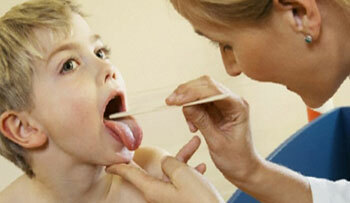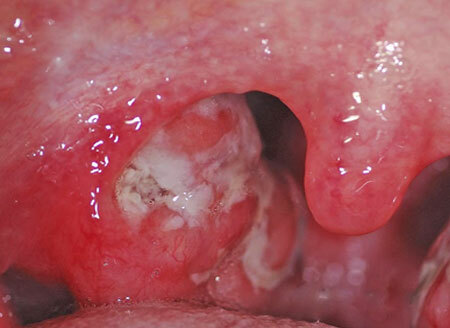The diagnosis of sore throat is familiar to every person since childhood. With its unpleasant symptoms, not only children, but also adults of any age are confronted. It should be noted that as the person ages, the frequency of angina is reduced.
This is due to the fact that in childhood a pharyngeal ring is the most powerful barrier of all defense mechanisms. So conceived by nature. It contains a large number of macrophages and cells of the lymphatic system, secretory cells of the mucous and salivary glands are active, and the epithelium of the respiratory tract provides powerful protection.
It is the first to take the impact of pathogenic pathogens, preventing them from penetrating deeper and causing bronchitis, pneumonia and other diseases. Over the years, the activity of the entrance gate is falling.
Thus, acute tonsillitis( angina) is a kind of protection of the body from deeper penetration of microbes.
Contents of
- 1 What is lacunar angina?
- 2 Causes of lacunar angina
- 3 Symptoms of lacunar angina, photo
- 3.1 Symptoms in children, features of
- 4 manifestation Treatment of lacunar sore throat in children and adults
- 4.1 Complementary therapy
- 4.2 Features of lacunar angina treatment in children
- 5 Complications of lacunar angina
What is it?- Lacunar angina?
When a microbe number and aggression can overcome the barrier of the pharyngeal ring - a person has inflammation of the tonsils with subsequent damage to the whole body.

Sore throat with lacunar form of sore throat, photo
Acute tonsillitis or tonsillitis is a common( systemic) acute infectious disease with the predominant defeat of palatine tonsils.
According to the International Classification( ICD-10), lacunar angina is included in the list of banal primary angina( follicular, lacunar, catarrhal and necrotic).There also includes secondary( atypical) forms, in which tonsils are affected in passing. Occurs in measles, rubella, infectious mononucleosis, leukemia, agranulocytosis.
Many angina are similar - they all affect the palatine tonsils. Difference in the severity of the process, the nature of the location of the purulent deposit, the type of pathogen and the features of the treatment.
Lacunar angina is a type of purulent sore throat, in which the plaque is located in the lacunae of the tonsils.
Causes of lacunar sore throat
Most often it occurs as a result of damage to the tonsils with B-hemolytic streptococcus. Less commonly streptococci of other groups, viruses, atypical pathogens.
In children under three years of age, as a rule, viruses cause angina.
The high incidence is due to the ease of transmission of the pathogen. From a sick person, it is transmitted through the air, with water and food, through household items, toys.
It is not uncommon for autoinfection to be the cause of sore throat. Because of the weakening of immune forces, microbes living on the mucosa are activated, an inflammatory focus occurs in the place of accumulation of lymphoid tissue.
Symptoms of lacunar angina, photo
Angina can not imagine without a sore throat. This is the leading symptom. Additional complaints are painful swallowing, enlarged cervical and occipital lymph nodes. These are local symptoms.

Photo of the throat - symptoms of lacunar angina
However, if you consider that angina is a systemic disease, the pathology will spread to the entire body and general symptoms will appear. These include: fever, headache, tachycardia, joint pain.
Almost all acute tonsillitis have a similar clinical picture. But lacunar angina has its own characteristics.
What you should pay attention to:
- A more pronounced onset of the disease, with a sharp rise in temperature to 40 degrees.
- More severe course compared with catarrhal or follicular angina due to intoxication.
- The specific location of the raids is a region of lacunae( grooves) behind the tonsils. Sometimes they merge, forming a film covering the entire surface.
Often confused lacunar and follicular angina. The picture in the throat with follicular angina was accurately described by the famous physician N.P. Simanovsky: on the reddened surface of enlarged tonsils, there is a plaque of pus in the form of a "starry sky".This is an important diagnostic feature.

High temperature is a sure sign of
As soon as lacunar tonsillitis takes place on the plaque( 3-4 days) the general condition immediately improves. The temperature drops to subfebrile and lasts another day or two. Common symptoms of intoxication subsided.
Symptoms in children, especially the manifestation of
 . The children's immune system can react violently to streptococcal angina. What is expressed by more pronounced symptoms of infectious poisoning. At the height of the fever, convulsions, chills and delirium are often noted. The upper respiratory tract becomes swollen, which disrupts breathing.
. The children's immune system can react violently to streptococcal angina. What is expressed by more pronounced symptoms of infectious poisoning. At the height of the fever, convulsions, chills and delirium are often noted. The upper respiratory tract becomes swollen, which disrupts breathing.
Children begin to choke and become blue. Such a dangerous condition often ends with hospitalization.
In children under three years of age, on the contrary, the angina flows easier than usual. The reason is that it is caused by viruses.
Treatment of lacunar sore throat in children and adults
The correct approach in the treatment of lacunar angina is:
- Identify with the causative agent( identify) before starting treatment( carry out diagnosis).
- Drink an antibiotic to which there is no resistance of the pathogenic microbe( it is prescribed by a doctor! , according to the results of the diagnosis).
- Observe the full course of antibiotic therapy to avoid further difficulties in treatment.
To diagnose the pathogen, apply laboratory antigen tests and isolate the culture( make the pot sowing on the flora).They should be performed in all cases of angina. It is a pity that the result of planting is not obtained immediately, but only after a day. This is the drawback of the method.

Tests for streptococcal antigens, in contrast, are held for several minutes literally at the patient's bedside.
In real life, often antibiotics for lacunar angina have to be appointed blindly, guided by the recommendations of specialists. They prefer b-lactams - phenoxymethylpenicillin, amoxicillin and cephalosporins of the first generation. With allergies to these drugs - macrolides.
The optimal drug is "Amoxicillin" in the form of solute. In addition to "Amoxicillin", you can use cephalosporins I - "Tsefaleksin."Such treatment of lacunar angina in adults.
Additional therapy
This includes topical therapy with topical antibiotics and antimycotics, antiseptics, immunomodulators. Appropriate anesthetics and anti-inflammatory drugs.
Homeopathic remedies and strengthening exercises for the muscles of the pharynx have not lost their meaning.
Bed rest is recommended. Light, nutritious food, mainly milk, vitamins. The abundant drink is shown.
Features of treatment of lacunar angina in children
Children under three years of age - often drug treatment is not required. Even streptococcal angina is not severe and does not cause complications. At this age, you should limit the intake of drugs and manipulation. Do not try to use iodine-containing drugs, chlorhexidine, propolis, various sprays and biseptol.
Children up to the age of five may experience fungal angina. Then "Fluconazole" is shown.
Classical lacunar angina appears from six years. In this case, antibiotics are shown in the form of an oral soluble form( Phenoxymethylpenicillin suspension, Amoxicillin, Solutab).
All medicines, especially antibiotics, should be prescribed by a doctor - do not self-medicate! Complications of lacunar sore throat
For lacunar angina this is characteristic, because to streptococcal tonsillitis there is no persistent immunity. And during the recovery period, complications are typical:
- paratonsillar abscess, otitis media;
- acute rheumatism;
- rheumatic heart disease;
- acute and chronic glomerulonephritis
The complication is indicated by a repeated wave of fever( after 7-10 days) from the onset of tonsillitis. The disease takes a long time. Complete recovery does not occur. This signal for examination, apparently, there was an undesirable complication.
To reduce the risk of tonsillitis, children need to be accustomed to hygienic measures: wash hands often, do not pull other people's toys into their mouths.
And adults - to observe the terms of treatment and doctor's recommendations.



